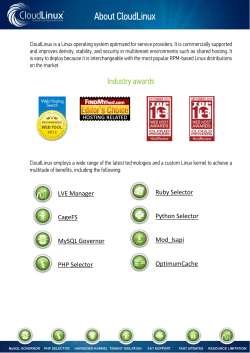
UFCEUS-20-2 Web Programming Multitier Architecture, MySQL & PHP
UFCEUS-20-2
Web Programming
Multitier Architecture, MySQL & PHP
Multitier architecture :
In software engineering, multi-tier architecture (often referred to as
n-tier architecture) is a client–server architecture in which
presentation, application processing, and data management functions
are logically separated. For example, an application that uses
middleware to service data requests between a user and a database
employs multi-tier architecture. The most widespread use of multi-tier
architecture is the three-tier architecture.
N-tier application architecture provides a model by which developers
can create flexible and reusable applications. By segregating an
application into tiers, developers acquire the option of modifying or
adding a specific layer, instead of reworking the entire application.
Three-tier architectures typically comprise a presentation tier, a
business or data access [logic] tier, and a data tier.
(Wikipedia : Multitier Architecture)
3-tier architecture (application view)
Advantages of the 3-tier architecture approach :
o
the ability to separate logical components of an
application ensures that applications are easy to manage
and understand.
i.e. experts can be employed that specialise in one of the
layers e.g. user interface design
o
because communication can be controlled between each
logical tier of an application, changes in one tier, for
example, the database access tier, do not have to affect
the client component
i.e. a change from one DBMS to another would only
require a change to the component in the data access
layer with little or no effect on the business/logic (middle)
or UI layer.
o
specific tools and technologies suited to each layer can
be deployed (and may evolve at a different pace) .
Typical web-oriented 3-tier architecture
Web-oriented 3-tier architecture:
tools & technologies
Presentation tier – Browser / custom client, Client Side
Scripting (JavaScript, ActionScript, VBScript etc.), Applets.
o
Logical Tier – Web Server (Apache, IIS, Websphere etc.);
Scripting Languages (PHP, Perl etc.), Programming Languages
(Java, C, C# etc), Application Frameworks (Ruby on Rails etc.)
o
Data Tier – Database Management System (DBMS)
(Oracle, MySQL, SQL Server, DB2 etc.), XMLDB
o
MySQL in the persistence / data tier :
MySQL
o Open Source (relational) database server
- Runs on many platforms (Unix & Windows)
o Networked server – no fancy GUI like MS Access.
- You can find clients (such as phpMyAdmin) that provide a
GUI.
o Great for small, medium to large-sized applications (ebay,
amazon, facebook etc. all make use of it)
MySQL in the persistence /data tier :
MySQL Strengths
o High performance
benchmarks very well against commercial dbs
o Low-cost
no cost under open source licence
o Easy to configure and learn
easy to set up, SQL compliant
o Portable
Linux, Unix and Windows versions
o Open Source
source code is available for modification
phpMyAdmin
o A MySQL client written in PHP
o Via a browser you can :
o Manage Databases
o Manage MySQL users
o Create tables, add/edit/delete data, browse data
o Submit queries (SQL)
o Import and Export tables
o A great way to learn SQL!
o phpMyAdmin @ localhost : http://localhost/phpmyadmin
phpMyAdmin interface:
pop-up
sql window
home
phpmyadmin
help
mysql
help
db status
manage users
import data
export db
databases
PHP (main) API’s for using MySQL
There are three main API options when considering
connecting to a MySQL database server:
o PHP's MySQL Extension - original extension which provides a
procedural interface and is intended for use only with MySQL
versions older than 4.1.3. Can be used with versions of MySQL
4.1.3 or newer, but not all of the latest MySQL server features
will be available.
o PHP's mysqli Extension - MySQL improved extension takes
advantage of new features found in MySQL versions 4.1.3 and
newer. The mysqli extension is included with PHP versions
5 and later.
o PHP Data Objects (PDO) - PHP Data Objects, or PDO, is a
database abstraction layer that provides a consistent API
regardless of the type of database server. In theory, it allows
for the switch of the database server, from say Firebird to
MySQL, with only minor changes to the PHP code.
Advantages of the mysqli API
o Object-oriented interface
o Support for Prepared Statements
o Support for Multiple Statements
o Support for Transactions
o
o Enhanced debugging capabilities
o
o Embedded server support
Note:
If using MySQL versions 4.1.3 or later it is strongly recommended
that the mysqli extension is used.
example MySQL db
Entity Model
Example records (3)
qid
quote
author
dob
dod
url
category
1
There is no remedy but to
love more.
Henry David
Thoreau
1817
1862
http://en.wikipedia.org/wi
ki/Henry_David_Thoreau
love
6
Work is the curse of the
drinking classes.
Oscar Wilde
1854
1900
http://en.wikipedia.org/wi
ki/Oscar_wilde
humour
11
Religion is what keeps the
poor from murdering the
rich.
Napoleon
Bonaparte
1769
1821
http://en.wikipedia.org/wi
ki/Napoleon
politics
example php script using mysqli
// Connect to the db
$mysqli = new mysqli('hostname','username','password','database');
//Send the query to the database and pull the records in a
// certain category using the SELECT statement
// If the result returns true
if ($result = $mysqli->query("SELECT quote, url FROM quote
WHERE category='love'")) {
// print out the number of records retrieved
echo 'For the category "love", there are '
.$result->num_rows.' records.<br/>';
// The "fetch_object()” method allows access to the returned
// rows within the resource object ($result in this case).
while ($row = $result->fetch_object()) {
echo 'Quote: '.$row->quote.' ';
echo 'URL: <a href='.$row->url.'>'.$row->url.
'</a><br/>';
}
}
else { // it’s an error & the query failed
echo $mysqli->error;
} // end else
$mysqli->close();
run example
Update / delete/ add new record using mysqli –
left as an exercise
© Copyright 2025





















